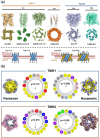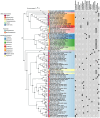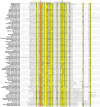The 6-kilodalton peptide 1 of the family Potyviridae: small in size but powerful in function
- PMID: 40539110
- PMCID: PMC12176749
- DOI: 10.3389/fmicb.2025.1605199
The 6-kilodalton peptide 1 of the family Potyviridae: small in size but powerful in function
Abstract
The Potyviridae family is one of the most economically significant groups of plant RNA viruses, causing severe yield losses in agriculturally important crops. Among the viral proteins encoded by potyviruses, the 6-kilodalton peptide 1 (6K1) has emerged as a critical, albeit poorly understood player in viral pathogenesis. Despite its small size, 6K1 exhibits diverse functions, including facilitating the assembly of viral replication complex (VRC), altering host membrane permeability as a viroporin, and interacting with host factors to promote infection. This review synthesizes current knowledge on 6K1, focusing on its structural characteristics, evolutionary conservation, molecular interactions, and potential as a target for antiviral strategies. We further discuss unresolved questions surrounding its putative ion channel activity, polyprotein processing dynamics, and functional parallels with animal virus viroporins. Understanding 6K1's multifunctionality provides new insights into viral infection mechanisms and opens avenues for novel disease control approaches.
Keywords: 6K1; Potyviridae; antiviral targets; membrane remodeling; viral replication complex; viroporin.
Copyright © 2025 Yu, Korxeelor, Wang, Chang, Jiang, Wu and Cheng.
Conflict of interest statement
The authors declare that the research was conducted in the absence of any commercial or financial relationships that could be construed as a potential conflict of interest.
Figures




Similar articles
-
A MicroRNA Screen Identifies the Wnt Signaling Pathway as a Regulator of the Interferon Response during Flavivirus Infection.J Virol. 2017 Mar 29;91(8):e02388-16. doi: 10.1128/JVI.02388-16. Print 2017 Apr 15. J Virol. 2017. PMID: 28148804 Free PMC article.
-
Ineffectual immunity in a resurrected mouse model of persistent viremia.J Virol. 2025 Jun 17;99(6):e0024825. doi: 10.1128/jvi.00248-25. Epub 2025 May 8. J Virol. 2025. PMID: 40338081 Free PMC article.
-
Antiviral effect of the viroporin inhibitors against Taiwan isolates of infectious bronchitis virus (IBV).Virus Res. 2024 Nov;349:199458. doi: 10.1016/j.virusres.2024.199458. Epub 2024 Aug 27. Virus Res. 2024. PMID: 39187047 Free PMC article.
-
Signs and symptoms to determine if a patient presenting in primary care or hospital outpatient settings has COVID-19.Cochrane Database Syst Rev. 2022 May 20;5(5):CD013665. doi: 10.1002/14651858.CD013665.pub3. Cochrane Database Syst Rev. 2022. PMID: 35593186 Free PMC article.
-
Behavioral interventions to reduce risk for sexual transmission of HIV among men who have sex with men.Cochrane Database Syst Rev. 2008 Jul 16;(3):CD001230. doi: 10.1002/14651858.CD001230.pub2. Cochrane Database Syst Rev. 2008. PMID: 18646068
References
-
- Amin H. A., El Kammar H. F., Saied S. M., Soliman A. M. (2023). Effect of Bacillus subtilis on potato virus Y (PVY) disease resistance and growth promotion in potato plants. Eur. J. Plant Pathol. 167, 743–758. doi: 10.1007/s10658-023-02774-0 - DOI
-
- Awaluddin F., Batubara I., Wahyudi S. T. (2023). Virtual screening of natural compounds against six protein receptors coded by the SARS-CoV-2 genome. Mol. Ther. 18, 147–158. doi: 10.20884/1.jm.2023.18.1.7884 - DOI
-
- Belabess Z., Tahiri A., Lahlali R. (2024). Contemporary perspectives on the global evolution of potato virus Y pathogen. Indian Phytopathol. 77, 13–34. doi: 10.1007/s42360-024-00709-1 - DOI
Publication types
LinkOut - more resources
Full Text Sources

